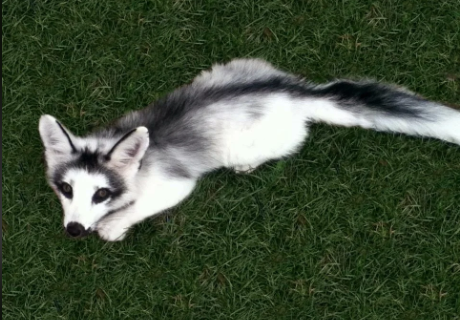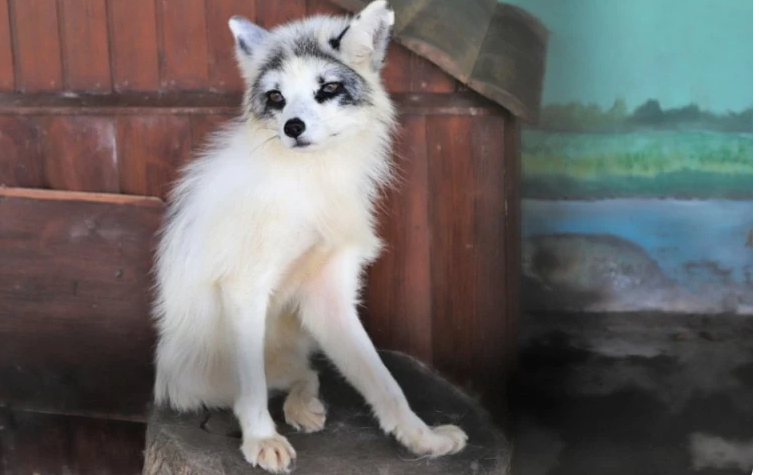What is a Canadian Marble Fox?

The Canadian marble fox, which is also called an Arctic Marble Fox or arctic fox, is a small fox that bears a cat-like appearance. It is a subspecies of the red fox, exclusive to a small region in Canada. The scientific name of the Canadian Marble Fox is Vulpes Vulpes Guttata.
These foxes are not naturally occurring in Canada; the first Marble Fox is believed to have originated in Norway in 1945 due to a genetic mutation resulting from the breeding of an Arctic Fox with a red fox.
The Canadian marble fox is named for the fact that its coat resembles stone marble. Their coat is soft. Its notable fur, marked with white, black, and gray patterns, give it a unique appearance. One of its feature is the dark rings around its eyes that look similar to what a raccoon would have. Generally, you will see their coat as mostly grey or tan with streaks of these colors, as well as black and white, throughout.
Canadian marble foxes vary in size depending on gender, with males typically weighing between 3.5 and 9 pounds while females weigh between 2.9 and 6.8 pounds. They measure around two feet long from nose to tail tip, with their tails accounting for about half of their body length.
These foxes are common in the northern regions of Canada, including the Arctic and sub-Arctic regions specifically in British Columbia, Alberta, and the Northwest Territories. They have adapted well to cold environments by developing thick fur coats that protect them from harsh weather conditions. They can be found across northern Canada, Alaska, Greenland and Russia’s far eastern regions.
The term “Canadian Marble Fox” is used because these foxes were intentionally bred in Canada and other Arctic Circle regions. Initially bred for the fur trade, today, some people sell Canadian Marble Foxes as pets in Canada and other parts of the world.
Canadian Marble Foxes are carnivorous animals feeding small mammals like rodents, rabbits, and birds. They are excellent hunters with sharp senses that enable them to locate prey quickly. Their preferred habitat includes open spaces and dense vegetation, such as shrubs and willow thickets.
Behavior
In the wild, Canadian Marble Foxes are solitary animals that hunt small prey such as rodents, birds, and insects. They have sharp teeth and claws designed to catch prey quickly and efficiently. Their hunting prowess makes them formidable predators despite being relatively small in size.
Adaptation
The Canadian marble fox is well-adapted to cold climates, with thick fur that changes color from brown in summer to white in winter for camouflage. They need this insulation to survive the harsh winters in their natural habitat. In addition to their fur, they have small ears and a short snout which help them retain heat in cold temperatures.
Their bushy tails are another distinctive feature; they help them balance when running through snowdrifts or leaping over obstacles. The tundra provides abundant food for these omnivores, including lemmings, voles, birds, eggs, berries, and carrion.
Conservation Status
The Canadian government has classified these foxes and wolves as species at risk due to habitat loss caused by climate change, human activities such as logging, oil drilling and mining operations encroaching on their territory or building roads through it. The fur trade also poses a threat to their survival. As a result, there have been efforts to conserve their habitats in the Arctic through protected areas like national parks. Sometimes, these foxes and wolves have been domesticated and bred as dogs for companionship.

Canadian Marble Fox Facts
| NAME | DETAILS |
| Common Name | Canadian Marble Fox (or Arctic Marble Fox) |
| Scientific Name | Vulpes Lagopus |
| Type | Arctic Fox |
| Diet | Omnivore |
| Ave. Life Span | 10 – 15 years |
| Weight | Male: 6 – 21 pounds; Female: 3 – 8 pounds |
| Height | Male: 18 – 27 inches; Female: 18 – 20 inches |
| Color | Marble (Mostly white with delicate streaks of gray, black, or tan artistically woven throughout) |
| Nature | Solitary hunter |